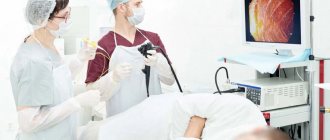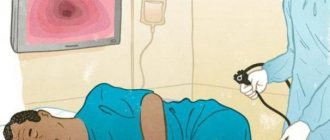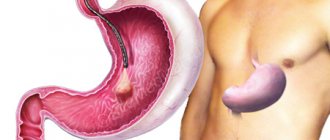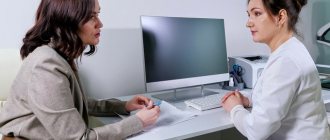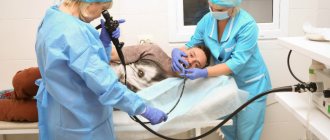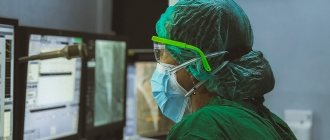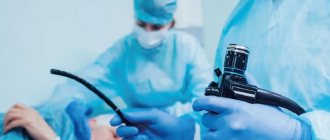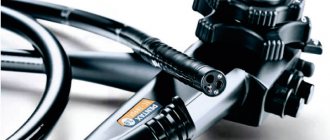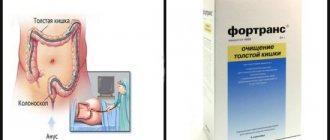What is this?
FGDS of the stomach is a highly informative diagnostic method that makes it possible to assess the condition of the mucous membrane of the gastrointestinal tract through probing. The probe is a long tube equipped at the end with a light source and a small camera that transmits the image to the doctor’s screen. Thanks to this it is possible to:
- Determine the actual amount and size of damage to the stomach wall, as well as the nature and depth of the wound.
- Identify the source of bleeding and eliminate it (gastroscopy allows minor surgical interventions to be performed in parallel with diagnosis).
- To evaluate the effectiveness of prescribed medical therapy for peptic ulcer disease.
- Monitoring the growth and changes of benign neoplasms and timely detection of malignant degeneration.
To carry out this diagnostic procedure, the patient must lie on his left side and hold the mouthpiece with his teeth. After this, the doctor inserts an endoscope into his oral cavity, smoothly moving along the esophagus into the stomach cavity, simultaneously examining the surrounding tissues for the presence of any defect. As a rule, no anesthesia is used for this procedure. However, if there are indications or the patient’s personal desire, local and even general anesthesia can be used.
The results of the examination, in most cases, are reported immediately. But if it is necessary to take biological material for additional microscopic examination, the announcement of the diagnosis may be postponed.
“We can do more than our patients think. Even some colleagues don’t always know what we are capable of,” says Alexey Petkevich, an endoscopist with 22 years of experience. He has performed several thousand endoscopic procedures and operations, thanks to which his patients did not end up on the operating table of surgeons. About the features of gastro- and colonoscopies, screening and prevention of colorectal cancer, the possibilities of its treatment at the RCMC - in an interview with a specialist.
Alexey Alekseevich Petkevich.
Endoscopist, head of the endoscopic department of the Republican Medical Clinical Center. Work experience - 22 years. In RCMC - since 2010. Before that, he worked as a doctor at the Polotsk Oncology Center for 12 years. “The main rule is this: if a person has a stomach ache and he cannot explain to himself the cause of the pain, he definitely needs to see a doctor.” “
In our department, we conduct two main studies: gastroscopy and colonoscopy,” Aleksey Alekseevich begins the conversation. — A little less often, because bronchopulpomonology is not our specialty, we do bronchoscopy. This means that the endoscope is inserted into the lumen of the bronchial tree, and we can see a lot: tumors, narrowings, and foreign bodies.
Today, endoscopy has made great progress. We can do more than our patients think. Even some colleagues don’t always know what we are capable of. In cases where previously there were all indications for surgical treatment, we can now help endoscopically.
- For example?
“We recently worked with a patient who had very complex choledocholithiasis. A huge stone was discovered in the bile duct, which had formed after the gallbladder was removed. The size of the stone was about two centimeters; it was impossible to catch it with the endoscopic basket. In different clinics they tried to help the girl more than once by penetrating the bile duct through the duodenum. But they couldn’t, because the case was really difficult.
We decided to carry out a rather complex procedure: we cut the papilla of Vater with a needle, penetrated it with a cholangioscope [a subsidiary endoscope that is inserted into the main one. - Note], they found a stone. Then they used a laser to destroy it into small pieces that could be removed with ordinary baskets.
In general, today this is a fairly developed branch of endoscopy, which opens up a lot of opportunities. In essence, we are taking work away from surgeons, which benefits patients: during surgical operations, the rate of complications is an order of magnitude higher.
— What usually brings a person to endoscopic examinations?
— I would divide endoscopy from the point of view of prevention and treatment into two large groups: the one where there are no indications for endoscopy, and the one where there are.
“Indicated without indication” is another way to call screening. We have developed colon screening in our clinic. We conduct its study without indications or symptoms in patients over 50 years of age. Although, I think this lower threshold will shift to 45 years. If there are indications for gastro- or colonoscopy, then, as a rule, patients are referred for these procedures by therapists, gastroenterologists or surgeons. The patient should not prescribe endoscopy for himself. What symptoms usually bring people to the doctor? In the esophagus - this is a violation of swallowing, in the stomach - pain in the upper abdomen. In the large intestine - constipation, diarrhea, blood in the stool. A drop in hemoglobin can be a symptom of both stomach and colon diseases. In this case, endoscopic examination is also indicated. The retelling can take a long time.
Therefore, the main rule is this: if a person has a stomach ache and cannot explain to himself the cause of the pain, he should definitely consult a doctor.
Abdominal pain, indigestion, loss of appetite or increased appetite may all be indications for testing. But differentiating pain is the doctor’s concern. The patient cannot diagnose himself. He will only read articles on the Internet and find one diagnosis worse than another.
Gastroscopy: when is it prescribed, how long does the procedure last, how to prepare for it and why do a biopsy
— Let's talk about gastroscopy. Performing this procedure, which is commonly called “swallowing a probe,” is not always easy. What challenges do you face and how do you solve them?
“There are patients who have a strong gag reflex or are not psychologically ready for this study. Some people are so stressed that they basically cannot undergo the examination without anesthesia. In such cases, intravenous anesthesia helps. The patient is sleeping, the doctor is performing the procedure. Everything goes smoothly.
- Who decides whether to give anesthesia?
— The patient together with the doctor. It happens that at the initial appointment a person does not know that he may have a similar reaction. And when he comes for research, the tense state may come as a surprise to everyone. In order not to harm the patient, we stop the procedure and give a recommendation for subanesthetic endoscopy. Before it, the patient must be examined and prepared. There are no problems with this in our clinic.
— How long does the procedure take under anesthesia?
- The same as without it. An examination of the stomach, for example, lasts about 7 minutes.
Some patients ask: “Do it for me quickly.” But this is the wrong approach. It must be done as long as necessary to examine all areas of the stomach, scan in a narrow spectrum of illumination, assess the condition of the mucous membrane, identify submucosal formations, narrowing or compression of the stomach, and so on. A quick examination can reveal gross pathology, but anything less noticeable requires a more detailed examination.
— What rules should the patient follow before the gastroscopy procedure?
- First of all, it must be on an empty stomach. Food leaves the stomach on average after six hours - from 4 to 8. If patients have narrowing or ulcerative scars, then this period extends to 12 hours. We generally recommend not eating after 6 pm the night before, but drinking is fine. In the morning - neither drink nor eat. The stomach should be empty.
— What is dangerous about breakfast or a light snack before the procedure?
— Firstly, food residues interfere with research. Secondly, they are truly unsafe for the patient. If vomiting occurs, a person may accidentally inhale food, causing pneumonia.
Experienced doctors can distinguish food that has just been eaten from food that has been in the stomach for many hours, no matter how disgusting it may sound to the average person. We see that some people forget about the rule and hope to “slip through somehow.” But this is really dangerous, especially if they mislead the anesthesiologist. If a patient vomits unnoticed while under anesthesia, this can even lead to death.
Therefore, we have a rule: if we go into the stomach with a probe and see that there is food there, we immediately take out the endoscope and stop the study, because this is dangerous not only for the health, but also for the life of the patient.
— Is a biopsy always done during gastroscopy? What does this depend on?
— With conventional endoscopy, if we do not see indications for an extended biopsy, material is taken from two zones: from the antrum and body of the stomach. This is necessary in order to assess the presence of Helicobacter infections and atrophy (thinning of the gastric mucosa), which in the future can lead to a malignant process.
Is a biopsy always performed? We insist that this always be the case. The exception is when patients are on drugs that reduce blood clotting. Otherwise it may lead to bleeding. It happens that we do not do a biopsy if the patient refuses. He has this right.
Colonoscopy: how to overcome fear, why anesthesia, how to prepare for the examination
— From the age of 50, Belarusians are subject to a colorectal cancer screening program and must undergo a colonoscopy. Right?
- Yes. From 2014 to 2018, research work was carried out at our center. This was a large program for screening and secondary prevention of colorectal cancer in Belarus, for which we took the best world experience. Its result was the creation of an order, thanks to which colon cancer screening is being introduced in the country.
Moreover, of all cancer localizations, this screening can be called the most difficult - in terms of its organization and implementation.
- Why?
- At least because of the psychological barrier. It is one thing to take blood from a vein, another to do a colonoscopy, in which a probe is inserted through the anus. In addition, feces are examined for occult blood. This means you need to take a sample yourself. For many, this is a difficult psychological barrier to overcome.
Plus, to perform a colonoscopy, the intestine must be prepared - it must be washed of feces. This is not always easy either. If anyone has been preparing, they will understand immediately. If not, then this is what it looks like: you need to drink 4 liters of the drug and survive the induced diarrhea.
It is not easy to persuade people to undergo these procedures. When we were working on the program, every fifth person refused to participate in it for free.
— A 50-year-old person who is eligible for colorectal cancer screening undergoes a colonoscopy. If nothing is found, when should it be done next time?
— Primary colonoscopy is done at 50 years of age. Based on its results, it is determined how long it will take to carry out the procedure next time.
If the colon is absolutely clean, the doctor did not find anything - the next colonoscopy should be done in 10 years. If there are polyps, the period depends on their number and morphological state. On average - from 3 to 5 years.
Every year, colonoscopy is performed only for those who have a genetic predisposition to colon cancer. These patients are only 10 percent.
There is no fulminant course of cancer. It has been proven by science: if nothing is found in the intestine, if its mucous membrane is clean, without adenomas, then in 10 years a person will not die from cancer. And even if after 10 years something appears, it will be curable and treatable. We did not come up with this standard; it is practiced in the USA and Europe.
— Your colleague, oncologist Yuri Slobodin, says that now the rate of development of colorectal cancer is such that it can come out on top. Are you also seeing this trend?
- Certainly. We identify an adenoma (polyp) in every third patient. This is a strong indicator for assessing the work of the endoscopist in particular and the endoscopy department in general. If it is below 20 percent, it means that the endoscopist is not working well.
Our average rate for the screening program, that is, among patients who did not need to have a colonoscopy according to indications, is about 35 percent. Interestingly, the figure is approximately the same in the group of patients aged 45-50 years.
— Are polyps the precursors of colorectal cancer?
- They are called adenomas in another way. It is believed that this is an intermediate stage between healthy mucosa and cancer. Adenoma has two degrees of dysplasia: low and high. The next step is cancer.
— If the patient is under 50 years old, for what indications can he be prescribed a colonoscopy?
- When a person has unexplained constipation, diarrhea, bleeding in the stool, decreased hemoglobin, or large tumors are found in the abdominal cavity, metastases without a primary focus.
— Is colonoscopy always performed under anesthesia?
— There is a group of patients who can have a colonoscopy really painlessly. But, unfortunately, not everyone.
I have been working as an endoscopist for 22 years and have more than once entered into discussions with younger colleagues who say that “yes, everyone can do it without anesthesia.” To which I answer: “A patient to whom you could not do it simply did not come to you.” I've performed over 11,000 colonoscopies and I'm probably qualified to say that.
Most patients need to have a colonoscopy under anesthesia or sedation. The patient must be calm during the procedure. Then, accordingly, the doctor will be calm. All together this means that the level of diagnosis will be higher. When the doctor gets tired of the patient’s nervousness, his eyes become blurred. This increases the likelihood of overlooking minor pathologies. Sometimes nurses help. Ours are already so experienced that sometimes they see polyps before the doctor. I am happy to work with such colleagues. And this does not at all humiliate my dignity as a doctor.
— That is, anesthesia is used in cases where it is impossible to carry out the procedure without psychological stress?
— Let's put it this way: about 90 percent of our procedures are performed under intravenous anesthesia. This is the highest figure. We were the first to establish such a flow. We have a recovery room and all the conditions so that the patient is protected and we can perform the procedure painlessly.
During the first colonoscopy, I cannot predict how the patient will behave. And I won’t be able to give a guarantee that “I will treat this patient without pain, and this one with pain.” With anesthesia, I know for sure that the patient will be calm. But in general, the number of patients who write on the Internet that a colonoscopy is terribly painful is 5-10 percent. A person who has had the procedure done and was not in pain is unlikely to start writing reviews and spreading the word that he had a colonoscopy.
— How long does this procedure take?
— It all depends on the skill and qualification level of the specialist. As elsewhere, different people need different amounts of time to do the same job.
I can perform a colonoscopy in 20 to 40 minutes. But this does not mean that everyone can do this. It can be done in 15 minutes if the intestine is prepared and it is not anatomically changed. The Japanese standard is 5 minutes there, at least 10 minutes back. More is possible, and this is welcome. As paradoxical as it sounds, with experience and excellent equipment, our time for the procedure increases. Because in reality we see more complex things that are invisible on endoscopes of previous generations. If we find small polyps that do not raise doubts about the presence of invasive cancer, we remove them immediately. That is, the patient does not go to the second round - with repeated preparation for colonoscopy, four liters of the drug, and so on.
If there are doubts about polyps, we take a biopsy to examine the formation for the presence of cancer cells.
— Do I understand correctly that a polyp will sooner or later turn into cancer?
- Not always. According to various sources, benign neoplasms of the colon transform into malignant ones in 8-15 percent of cases. But if we find an adenoma, then it needs to be removed. We will not leave it even with an 8-15 percent risk.
— What causes a benign tumor to become malignant? Just because it has such a “life cycle”? Or could this be influenced by some factors?
— There are a lot of factors. The first is nutrition. Today we cannot imagine our life without “chemistry”. Everything we eat eventually turns into feces. Naturally, all the substances eaten will be released along the gastrointestinal tract. They stay the longest in the large intestine. Accordingly, this is where they show their aggression most.
If we eat foods that contain fewer harmful chemicals, we will be less likely to get any tumors. If you constantly throw smoked meats, fats, and the like into your intestines, then the situation will be the opposite.
By the way, smokers have a very high risk of colon cancer. I don’t know how to explain this yet. But in studies of groups of smokers, the incidence of colon cancer is higher.
In general, colon cancer is spreading across the planet by leaps and bounds. In 2014, we prepared an article in which there was data that every year 600 thousand people die from colon cancer in the world. Five years later, this number surpassed the 800 thousand mark. And this is despite the presence of screening programs in many countries of the world. Morbidity and mortality rates are rising. Although there are countries, including the United States, in which both mortality from colon cancer and morbidity are decreasing.
***
— In your department, you have the opportunity to record the research itself. For what?
- Firstly, if necessary, review the recording with the surgeon and plan medical tactics.
We can also record the research and show it, in case there are questions that we didn’t see something.
It happens that patients go somewhere else for consultation. For example, to Israel. They take the notes and show them to other doctors.
— What can be considered complications during endoscopic examinations and operations?
— Endoscopy has two serious complications: bleeding and perforation.
I've had perforations on even the smallest polyps when I didn't expect it to happen. We analyzed situations and found reasons. In medicine, you need to treat any pathology with respect, because when a doctor begins to think that he has become something more than just a doctor and a person, then something terrible happens.
We must always remember that we are simple people who can make mistakes out of the blue. You need to be prepared for this at any moment. The most valuable clinic and the most valuable doctor is the one who knows how to not just operate, but how to get out of difficult situations. We don’t deliberately provoke them, but if something happens, it becomes a most valuable experience. Just like in aviation, all instructions are written in blood. It's about the same with us.
****
— Endoscopy is more than even your colleagues think, you said at the beginning. It gives more opportunities and fewer complications...
“And it is easier to tolerate, and patients recover faster than with surgery. After all, for example, with cholecystitis, it is not the site of the removed gallbladder that takes longer to heal, but the cut abdomen. Laparoscopic and minimally invasive surgeries can avoid this.
— How is the decision made: will a surgeon operate on a person or will an endoscopist work with him?
“We always have time to give it to the surgeons.” Therefore, we work with the patient as much as possible, doing everything possible with the arsenal of tools that we have.
If we see that we no longer have the opportunity to continue endoscopic treatment, we refer the patient to surgeons.
— What operations do endoscopists perform?
— First of all, submucosal desection. If there is no invasion - penetration into the muscular plate of the mucosa, then the malignant tumor can be removed. Basically, the fight is against tumors that have high-grade dysplasia, that is, when there is one step left to a malignant tumor, but it is still soft and can be peeled off. But you need to work like a jewel. However, as in any business.
Duration of the procedure?
FGDS is done after special preliminary preparation, including diet, giving up bad habits and stopping taking certain medications. As a rule, it is necessary to adhere to these preparatory measures several days before the scheduled day of the diagnostic procedure. This is a mandatory measure to obtain the most informative and accurate data. If we talk directly about gastroscopy, then its duration is approximately 5-10 minutes. This medical procedure is carried out exclusively by a qualified diagnostician in a specially equipped office with the necessary amount of endoscopic equipment.
This time is enough to assess the condition of the esophagus and gastric wall. If it is necessary to perform a biopsy (taking biomaterial for further microscopic examination) or obtain images, the duration of diagnosis may increase. Since FGDS involves swallowing and further advancement of the probe, some patients may experience discomfort and activation of the gag reflex. To prevent unwanted effects or pain, local anesthesia may be used. Taking into account pain relief, the procedure takes about 15-20 minutes.
.
Indications for use
A referral for an FGDS is issued by the attending physician if the patient complains of certain symptoms to assess the functioning of the gastrointestinal tract, if a tumor of the gastrointestinal tract is suspected, or if medical and surgical interventions are performed. Among the main indications for FGDS are the following symptoms:
- pain, discomfort in the epigastric region of unknown etiology;
- frequent heartburn;
- bloating;
- a sharp decrease in body weight;
- constant belching not related to food intake;
- repeated vomiting;
- suspicion of intestinal bleeding;
- swallowing dysfunction.
Gastroscopy can also be prescribed for other unpleasant symptoms, as well as for monitoring treatment and the dynamics of the disease.
What affects the time of gastroscopy?
Despite the fact that the average duration of an endoscopic examination of the stomach is 5-10 minutes, this period can be extended under the influence of several internal and external factors.
Among them:
- Psychological mood
. Most patients (especially those undergoing this examination for the first time) associate endoscopy with painful sensations. This creates a persistent fear in them, which negatively affects the formation of contact with the doctor. - Failure to comply with proper preparation
. If the patient did not adhere to the diet and consumed any food within a few hours or minutes, performing an FGDS may be difficult or even canceled. In this situation, active digestion of incoming food will occur in the stomach cavity, as a result of which it becomes impossible to assess the condition of the walls of the organ. - Use of anesthesia
. As mentioned above, if there are indications or personal desire, endoscopic examination of the stomach is possible under local or general anesthesia. This will require the involvement of an anesthesiologist, who individually selects the optimal drug and its dosage.
Is it possible to perform FGDS under anesthesia?
Anesthesia helps make the procedure painless.
To avoid discomfort during the examination, the patient may be given local anesthesia.
Although, more and more often, patients ask to be put under short-term anesthesia to avoid pain and unpleasant memories.
This is especially true for such categories of patients as children or neurasthenic people. But even for children, anesthesia is prescribed with extreme caution and only if it is necessary to carry out long-term manipulation and to exclude allergic reactions to the drug.
Although FGDS under anesthesia is completely unnoticed and painless, after the procedure is completed the patient may still complain of a painful sensation in the throat or an unpleasant feeling in the stomach.
What diseases can be detected using FGDS?
Gastroscopy of the stomach and other parts of the gastrointestinal tract can identify a number of diseases, including:
- stomach and duodenal ulcers;
- varicose veins of the esophagus;
- polyps in the stomach;
- duodenitis;
- pancreatitis;
- gastroesophageal reflux;
- inflammatory processes on the walls of the stomach;
- damage to the colon;
- cholecystitis;
- oncological processes of benign or malignant origin.
The EGD procedure of the stomach is effective in stopping internal bleeding; in the presence of a foreign body in the digestive system, it allows one to identify its location and carry out removal.
How is FGDS performed?
To understand how FGDS of the stomach is done, it is important to know that the procedure can be performed without anesthesia, under local anesthesia, or in a state of medicated sleep. The introduction of an anesthetic eliminates discomfort and reduces the urge to vomit. Many diagnostic centers offer the use of local anesthesia - treating the throat with lidocaine in the form of a spray.
The technique for performing FGDS consists of:
- the patient lies on the couch, on his side;
- the doctor inserts a plastic mouthpiece into the mouth - it helps prevent clenching of the mouth during the gag reflex;
- An endoscope is inserted through the mouthpiece, the patient is asked to take a deep breath;
- The endoscope tube is advanced into the esophagus and stomach.
After inserting the endoscope, the doctor examines the walls of the stomach, esophagus and intestines. The image is displayed on a computer monitor in real time. Thanks to modern equipment, during the study it is possible to obtain high-quality images that can be printed or sent to any medium. The FGDS transcript is sent to the attending physician, who uses the results obtained to make a diagnosis and prescribe the necessary treatment.
Using an endoscope, you can not only examine the upper gastrointestinal tract, but also administer medications to the affected area, stop internal bleeding or remove growths and tumors. According to indications, a biopsy or transendoscopic pH-metry can be performed.
How long an FGDS of the stomach lasts depends on the purpose of its implementation, but generally does not exceed 10-30 minutes. After it is performed, the patient remains in the clinic for 1-3 hours, then goes home.
